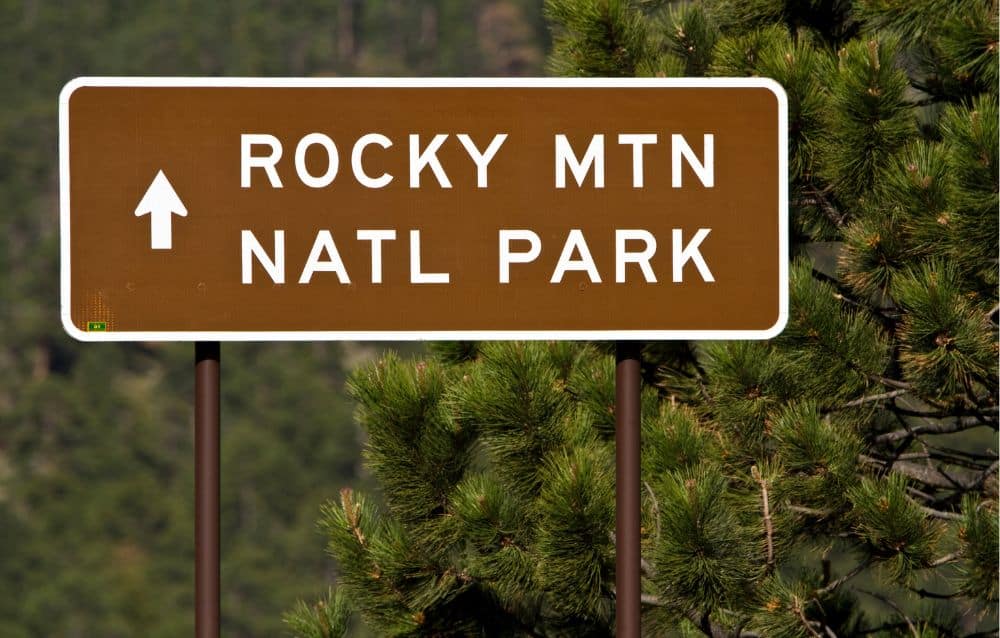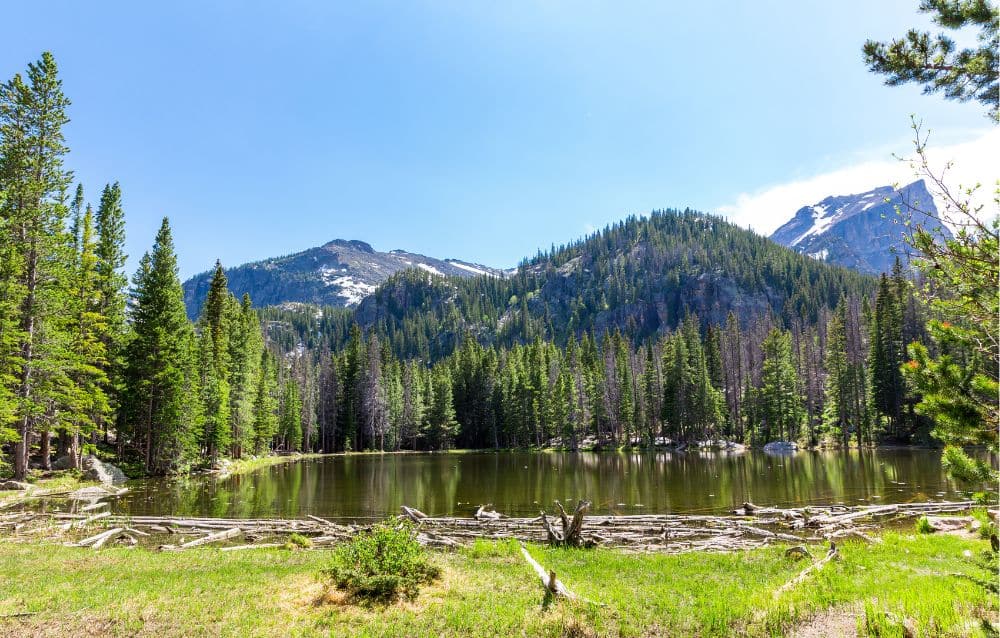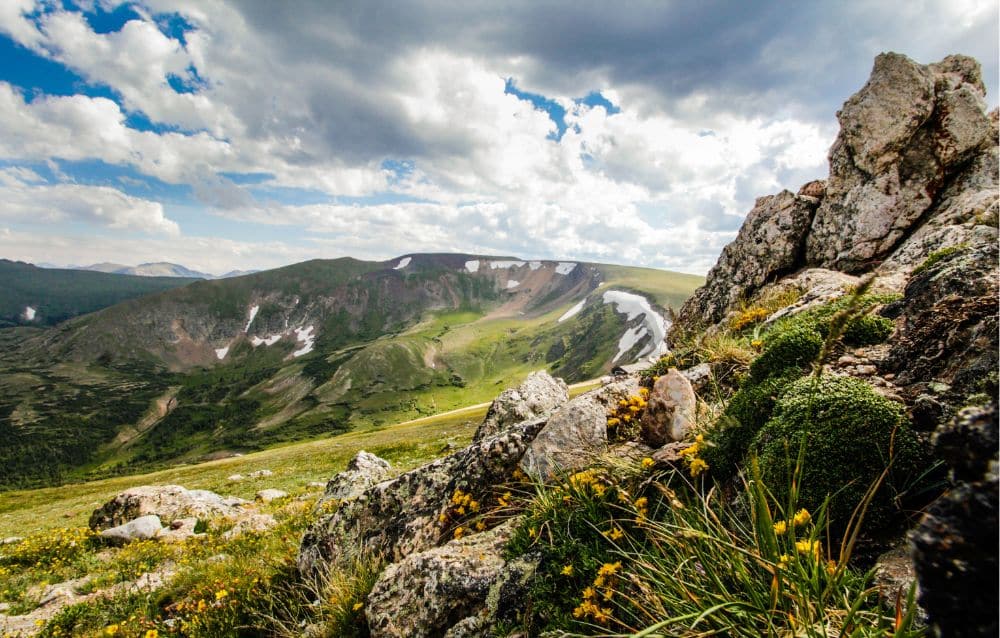No doubt about it. Rocky Mountain National Park is a hiker’s paradise. It’s got over 300 miles of trails ranging from easy lakeside strolls to challenging mountain ascents.
I’ve rounded up the absolute best trails that show off the park’s stunning alpine lakes, meadows full of wildflowers, and majestic mountain views. All you gotta do it lace up those adidas hiking boots and head on out.

1. Bear Lake to Emerald Lake Trail
This family-friendly trail is perfect for visitors who wanna experience multiple alpine lakes without a strenuous hike.
- Distance: 3.5 miles round trip
- Elevation gain: 650 feet
- Difficulty: Easy to moderate
- Trailhead: Bear Lake
Starting at the always popular Bear Lake, this trail takes you past Nymph Lake and Dream Lake before you reach the insanely stunning Emerald Lake nestled beneath the dramatic Hallett Peak. The trail gets pretty busy in the summer, so arrive early (before 8am) or use the park shuttle. In fall, the aspen groves along the way turn a brilliant gold. Honestly, that’s my fave time of year for this one.
2. Sky Pond via Glacier Gorge
This trail offers some of the most insanely beautiful scenery in the whole park.
- Distance: 9.4 miles round trip
- Elevation gain: 1,780 feet
- Difficulty: Strenuous
- Trailhead: Glacier Gorge
You’ll pass Alberta Falls, The Loch, and Lake of Glass before reaching Sky Pond. It sits in a dramatic cirque surrounded by sheer rock walls. Breathtaking. The scramble up a waterfall between Lake of Glass and Sky Pond adds a fun little challenge for the more adventurous among us. No denying that the views at the top are absolutely 100% worth every step.

3. Chasm Lake Trail
For mountain lovers, this trail delivers incredible views of Longs Peak’s dramatic east face.
- Distance: 8.4 miles round trip
- Elevation gain: 2,500 feet
- Difficulty: Strenuous
- Trailhead: Longs Peak
The trail climbs steadily through pine forests before opening up to alpine tundra with sweeping views. Chasm Lake sits at the base of the 1,000-foot vertical east face of Longs Peak, known as the Diamond. The reflection of the mountain in the lake on a calm day is something that will stop you in your tracks.
4. Alpine Ridge Trail (Tundra Communities Trail)
This short trail packs a big ole punch with panoramic views of the alpine tundra ecosystem. And, it’s pretty easy, so bonus for that!
- Distance: 0.6 miles round trip
- Elevation gain: 200 feet
- Difficulty: Easy
- Trailhead: Rock Cut on Trail Ridge Road
Located at 12,000 feet, this trail offers awesome views of the surrounding mountains and valleys. In summer, the alpine tundra blooms with tiny, colorful wildflowers. You’ll love it. Keep an eye out for yellow-bellied marmots and pikas scurrying among the rocks. Both are super cute. This is a great trail option for those who want big views without a long hike.

5. Mills Lake Trail
This moderate hike rewards you with a stunning mountain-ringed lake. Yes, please!
- Distance: 5.6 miles round trip
- Elevation gain: 750 feet
- Difficulty: Moderate
- Trailhead: Glacier Gorge
After passing the Instagram-popular Alberta Falls, the trail continues to Mills Lake, which delivers up spectacular views of the surrounding peaks including Longs Peak and Chiefs Head. The lake’s glassy surface creates perfect reflections of the mountains. (Good for your Insta!) For a longer adventure, continue on to Black Lake (an additional 1.8 miles one-way).
6. Deer Mountain Trail
This trail has got some of the best views-to-effort ratio in the park. And that’s saying something!
- Distance: 6 miles round trip
- Elevation gain: 1,210 feet
- Difficulty: Moderate
- Trailhead: Deer Ridge Junction
The well-maintained trail zig and zags up through pine forests and open meadows to the summit of Deer Mountain (10,013 feet). From the top, you’ll get panoramic views of Longs Peak, Moraine Park, and the Continental Divide. This is a good hike for acclimatizing to the altitude during your first day in the park. (Highly recommend it for this reason)
7. Fern Lake Trail
This trail showcases the park’s diverse ecosystems and stunning water features.
- Distance: 7.8 miles round trip
- Elevation gain: 1,400 feet
- Difficulty: Moderate
- Trailhead: Moraine Park
Following the Big Thompson River, you’ll pass Arch Rocks, The Pool (a whitewater feature), and Fern Falls before reaching the peaceful Fern Lake. The trail continues through forests and meadows with insanely beautiful wildflowers in summer. In fall, the aspen groves turn a vibrant gold, making this one of the park’s best autumn hikes. (Do it both seasons, if can!)

8. Twin Sisters Peak Trail
This less-crowded trail offers incredible views of Longs Peak and the eastern plains.
- Distance: 7 miles round trip
- Elevation gain: 2,500 feet
- Difficulty: Strenuous
- Trailhead: Twin Sisters Trailhead (outside the park’s eastern boundary)
The trail climbs up through pine and spruce forests before emerging above treeline. The final stretch to the 11,400-foot summit involves some rock scrambling. So, consider yourself warned, fam. From the top, you’ll checkout a unique perspective of Longs Peak and sweeping views of the Front Range and eastern plains. Since this trailhead is outside the main park entrance, it often sees fewer hikers – and that’s a big bonus.
9. Ouzel Falls Trail
This trail in the Wild Basin area delivers up multiple waterfalls and lush mountain forests.
- Distance: 5.4 miles round trip
- Elevation gain: 950 feet
- Difficulty: Moderate
- Trailhead: Wild Basin
The trail passes Copeland Falls and Calypso Cascades before reaching the impressive 40-foot Ouzel Falls. The Wild Basin area tends to be less crowded than other parts of the park, give you a more peaceful hiking experience. In early summer, you’ll be treated to wildflowers carpeting the meadows along the trail.
10. Longs Peak via Keyhole Route
For experienced hikers looking for a challenge, this iconic trail leads to the park’s highest summit.
- Distance: 14.5 miles round trip
- Elevation gain: 5,100 feet
- Difficulty: Very strenuous
- Trailhead: Longs Peak
This famous route to the 14,259-foot summit of Longs Peak is not a hike but a challenging mountaineering route that includes exposure, scrambling, and route-finding. Most hikers start around 2-3am to reach the summit before afternoon thunderstorms. Only attempt this if you’re well-prepared, acclimated to the altitude, and experienced in mountain hiking. Definitely not for noobs!

Tips for Hiking in Rocky Mountain National Park
- Start early to avoid afternoon thunderstorms and crowded parking lots
- Always carry plenty of water, snacks, sun protection, and layers
- Check the weather forecast and trail conditions at visitor centers
- Properly acclimate to the altitude before attempting strenuous hikes
- Use the park shuttle system during peak season to avoid parking hassles
- Purchase a timed entry reservation in advance during peak season (May-October)
Whether you’re looking for an easy stroll or a challenging adventure, Rocky Mountain National Park has a trail that’s perfect for you. The memories of standing beside a crystal-clear alpine lake or gazing out from a mountain summit will stay with you long after your visit.
